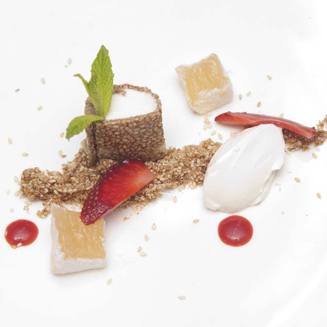
Instructions:
Lightly toast sesame seeds. Remove from heat and cover. Boil sugar in water, add lemon juice and honey and cook until syrup has thickened. Add sesame seeds to syrup and mix continuously until mixture has combined well. Spread out the sesame-syrup mixture onto a lightly greased baking pan or a flat marble surface. Drizzle with liqueur and flatten with the back of a spoon or spatula. Before it cools, cut into pieces. Sprinkle almonds on each piece.
Nutritional Value:
Pasteli is a nutritious and healthy snack choice. Compared to other snacks with a similar energy intake (caloric content) like chocolates, donuts, and cream filled biscuits, pasteli is richer in protein and fiber. While pasteli contains high levels of fat, it does not have cholesterol. Furthermore, the monounsaturated as well polyunsaturated fatty acids outweigh the saturated fatty acids, which are found in small quantities. It is worth noting that the principal polyunsaturated fatty acids are linoleic and linolenic acid, which are considered essential fatty acids because they cannot be synthesized by humans. Pasteli is high in vitamin E, calcium, phosphorus, potassium, magnesium and iron. Its high nutritional value is due to two main ingredients: honey and sesame seeds. Sesame seeds reduce blood cholesterol levels, strengthen the immune system, help prevent diabetes, protect against atherosclerosis and hypertension, prevent or slow down chronic diseases, contribute to the proper functioning of the liver and finally, have anti-aging and anti-hypertensive properties. It has also been found that the consumption of pasteli by people suffering from diabetes prevents hypoglycemia unlike the consumption of bread.
Historical Background:
Pasteli was usually sold at village fetes. The village of Zevgolatio is renowned for its delicious pasteli.
Source: Christina Karaleka- Dona (Kalamata) – Traditional cuisine of the rural areas of the Peloponnese 12/1977
Ingredients:
- 640 g sesame seeds
- 320 g sugar
- ½ teacup water
- 160 g honey
- lemon juice (1 lemon)
- liqueur for drizzling
- toasted almonds